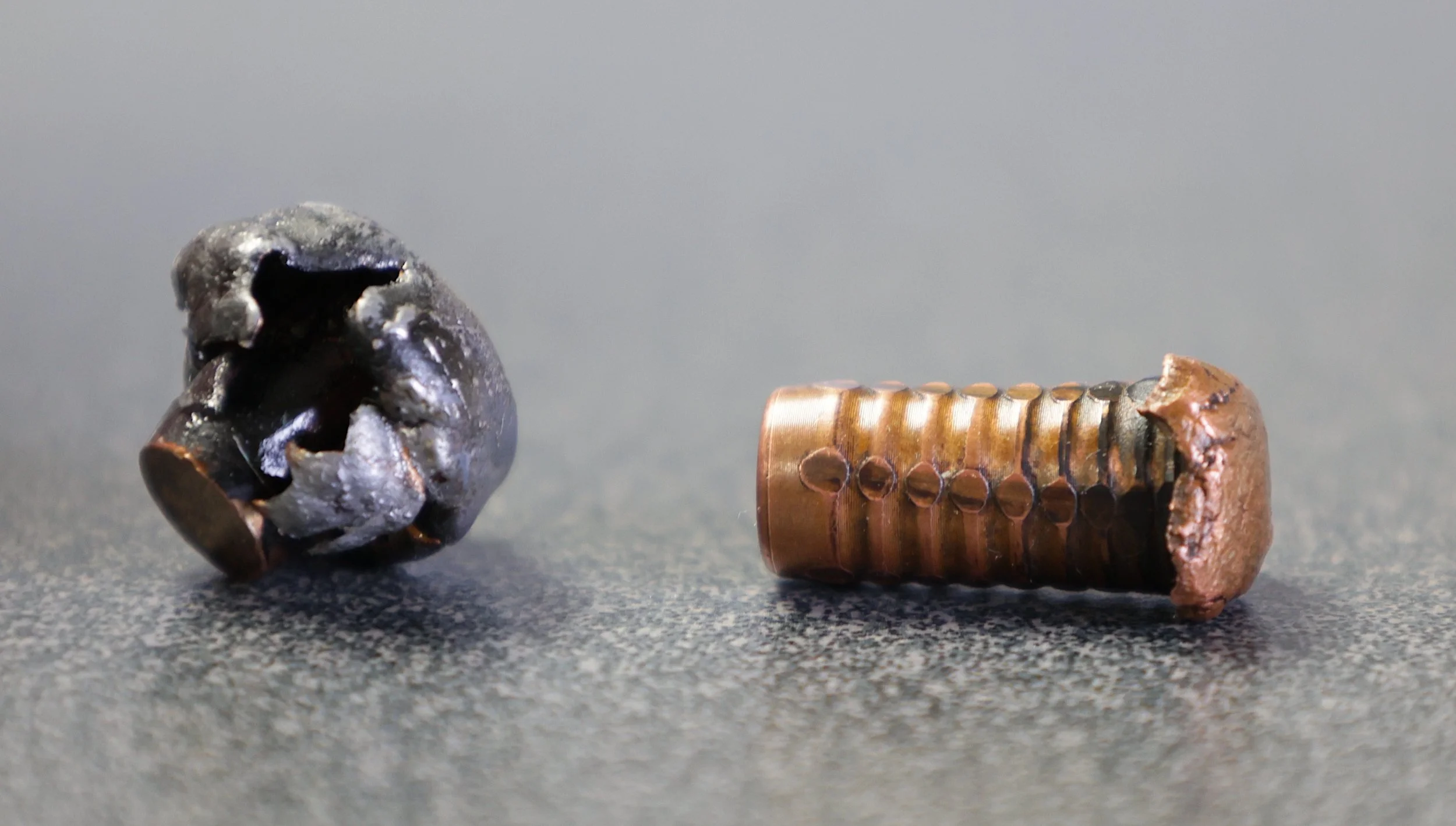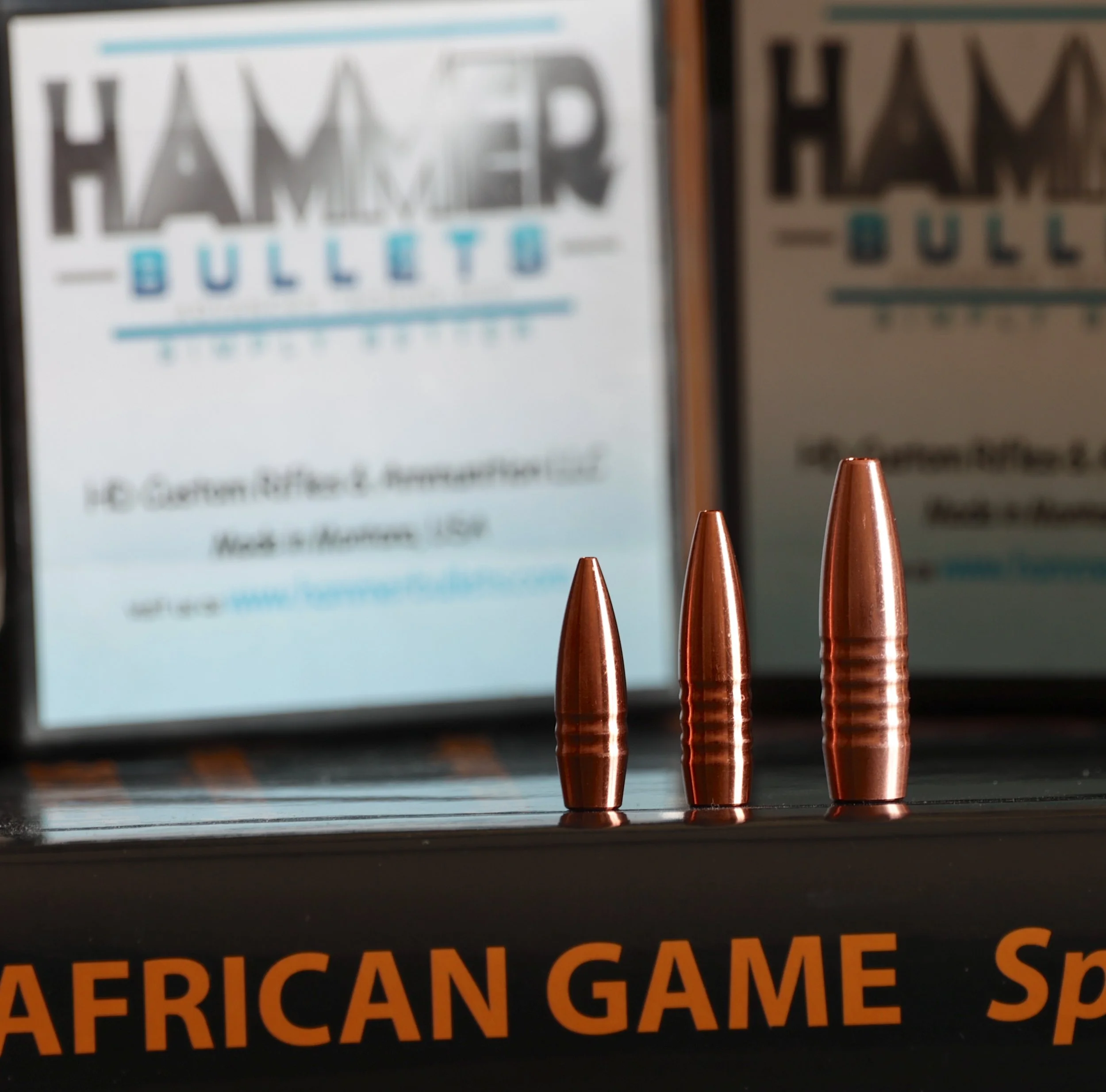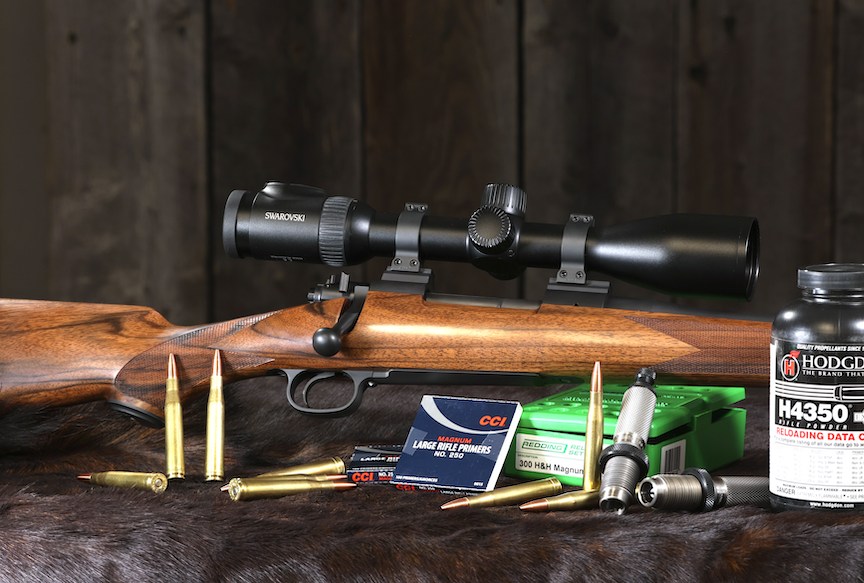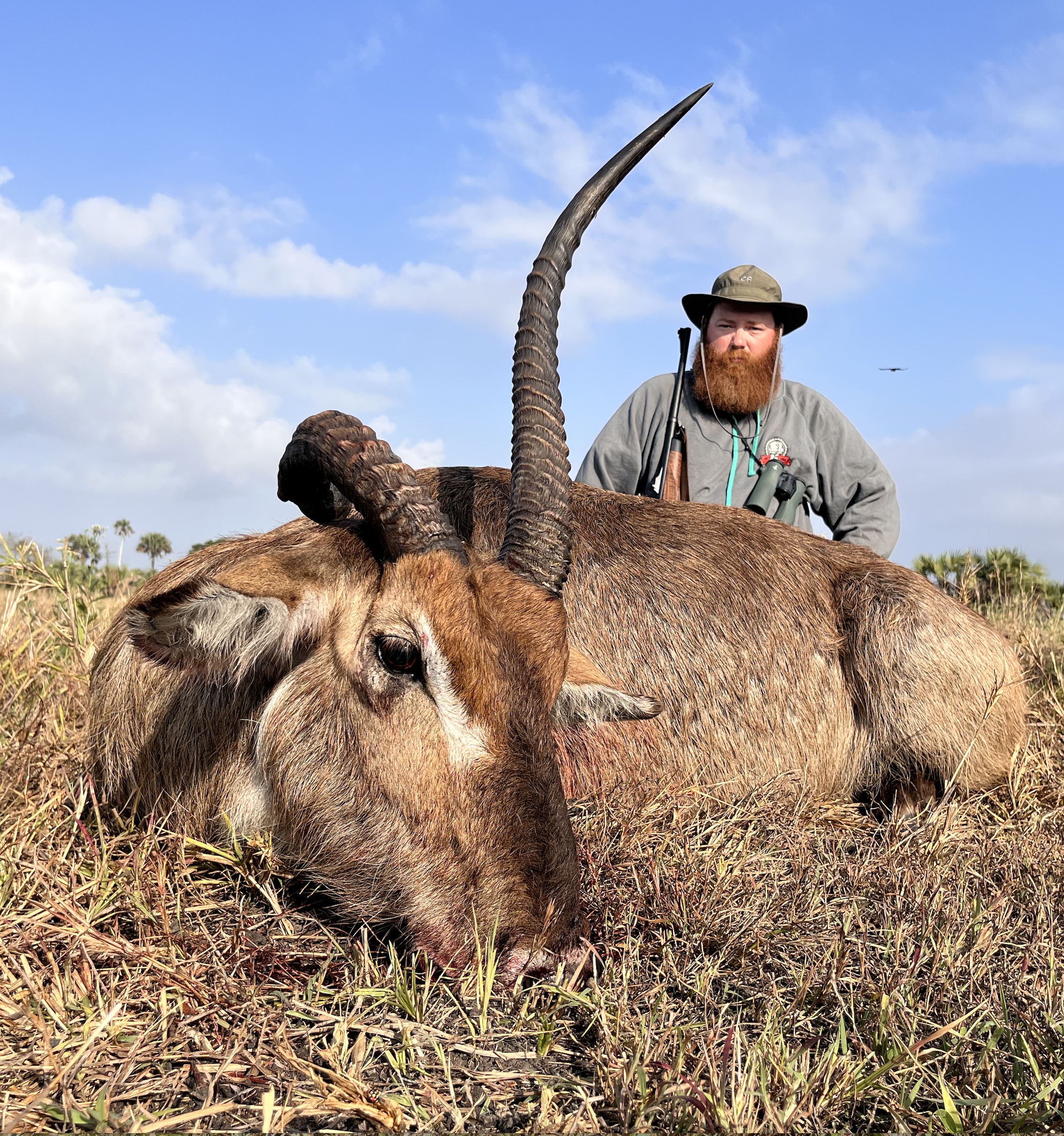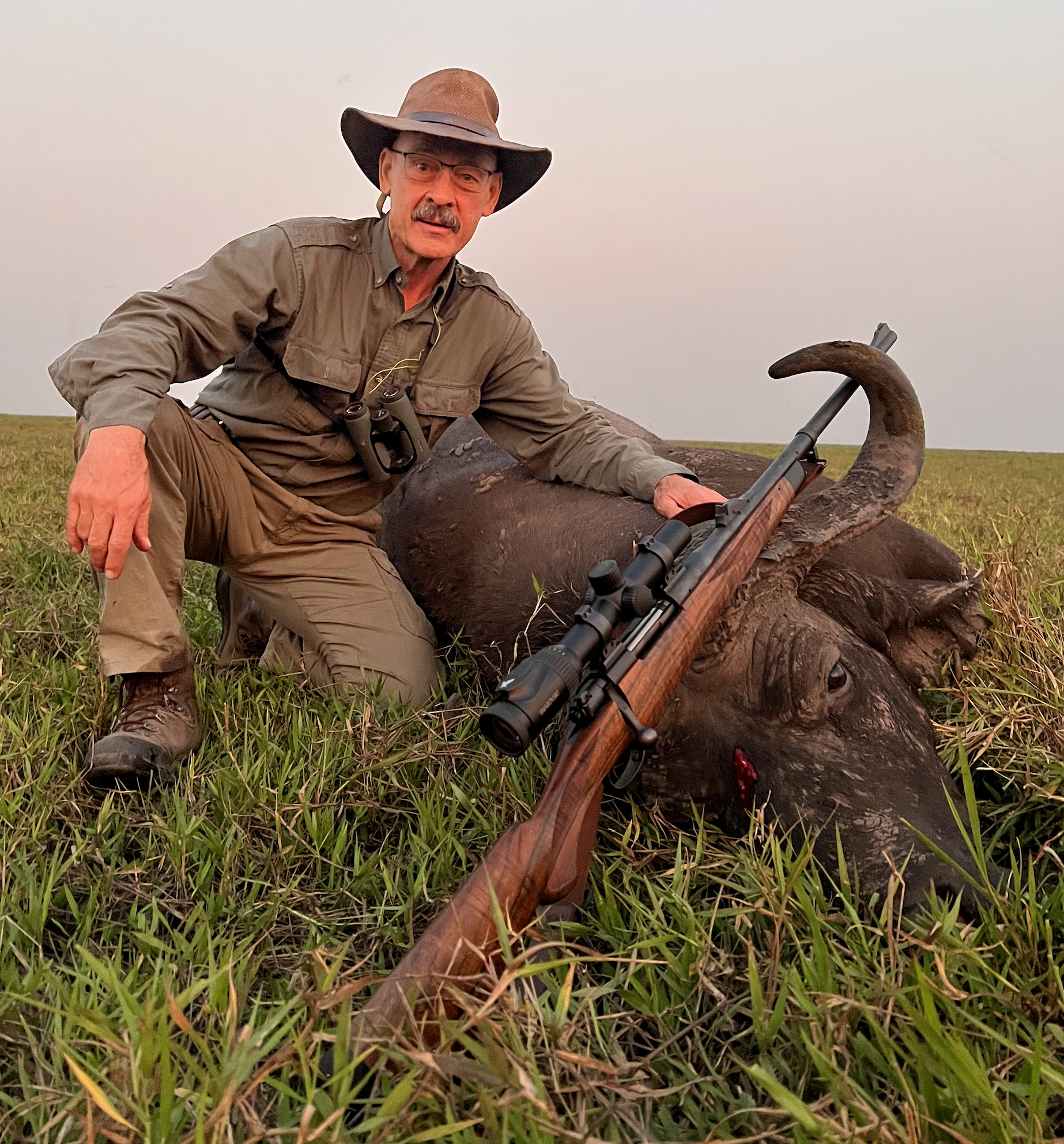Hammer Bullet Performance in Africa
270-grain Hammer Hunter .375 bullets, before and after Cape buffalo contact.
Can you really hammer everything from 1,500-pound cape buffalo to 100-pound reedbuck with an all-copper bullet designed to shed its nose petals? We took some Hammer Hunters to Mozambique to find out.
Hammer Hunters are an all copper alloy bullet with a hollow nose designed to break from the shank. Three or four petals divert from the main wound channel to cut and tear additional vital tissue. These petals perform much like traditional lead fragments from traditional cup/core bullets. Meanwhile the solid copper shank retains enough mass to maintain momentum for deep penetration. In addition, according to Steve Davis and Brian Holtmeyer, the bullet’s designers, the flat front of the shank radiates pressure at a 90-degree angle from the direction of penetration. Davis and Holtmeyer feel the rounded “mushrooms” of traditional bullets allow pressure and tissue to flow more gently around their curved surface. The question is, would African game feel the same thing?
Bonded lead core bullet compared to Hammer copper illustrates the “squared” face of the Hammer vs. the more rounded shape of the lead core. Theory is that the square nose radiates more damage at right angles to bullet travel. And the missing petals disperse through the animal to tear additional tissue. Note also the engraved tops of the relief grooves while the valleys remain unscared.
We planned to ask Cape buffalo, waterbuck, warthog, nyala, bushbuck and reedbuck. Those vary in size from roughly a small whitetail doe to a, well, 1,800-pound buffalo.
Prior to our Mozambique safari with Mark Haldane’s Zambezi Delta Safaris, my only experience with Hammer Hunter bullets on game was in working up loads for a 25-06 Remington (sub-MOA accuracy) and applying one 92-grain bullet to the chest of a whitetail doe. That bullet punched through both chest walls. So did three of its petals. Tearing of lungs and heart was severe. This did not, however, prevent the stricken doe from dashing a good 100 yards or slightly more before expiring. That might have concerned me more than it did because: A. The blood trail was extensive and expansive. Given the tracking/blood trailing abilities of African trackers, finding hard-hit game would be easy. And B. I’ve had dozens of whitetails hard hit by everything from 22-250 Remington through 300 Win. Mag. dash away as if untouched by a variety of traditional lead-core bullets.
The big question was whether the bullet’s tissue destruction would act quickly enough to stop a Cape buffalo before its remaining time on Earth brought its horn to our chests.
We were working with two traditional, walnut-and blued CRF Parkwest Arms rifles, a 300 H&H Magnum Legend and a 375 H&H magnum Savanna. I fitted a Swarovski Z8i 2-16x50mm in Talley Rings to the 300 H&H. Talley rings also secured the 1-8x24mm Z8i to the 375 H&H. I went with the illuminated reticle because my wife and I discovered the glowing red spot really helped us focus on the sticking place against a black buffalo hide, especially in low light. It wasn’t essential, but added a significant degree of confidence. As things turned out, I would end up taking my buffalo at last light with a tiny window for error. The illuminated reticle made a difference.
Our Parkwest Arms SD-76 fitted with Swarovski Z8i scopes in Talley rings were African classics. And deadly effective. Shot as good as they look! This is the old Dakota Arms M76 now being built by Parkwest Arms. That’s what I call a stick of walnut!
But before we detail that close encounter, more on those critical bullets. I emphasize critical because the bullet is the main player, second in line only to the hunter who launches it. Sure, a proper rifle and scope for sending that bullet are essential, but those are merely launching mechanisms. Come to think of it, so’s the shooter. It’s the bullet that does the real work. I’m always dumbfounded by hunters who dote on scopes and rifles and “calibers,” then buy the cheapest ammo/bullets they can find. Well, we weren’t doing that.
On the advice of Davis at Hammer, I chose a 270-grain Hammer Hunter bullet for the 375, a 150-grain for the 300, and some 124-grains in the 300 in case we found the 150s too fast/hard for the smaller, lighter game. (Turns out we didn’t, but the 124s killed just as well with less recoil for the women.) Friend and hunting partner Tyrell Bowen and I worked up handloads for both rifles, settling on slightly less than maximum powder densities of IMR4350 for 3,400 fps in the 300 H&H (150-gr.) and CFE223 to get an honest 2,800 fps in the 375 H&H. Those muzzle velocities are more than traditional for both, yet our loads didn’t show classic signs of excessive pressure and we were a grain off max loadings. Why the unusual speed? Based on reports plus my previous work with the 92-gr. Hammer in my 25-06, I have to credit the minimal bearing surface of Hammer bullets.
Here are the 124-gr., 150-gr. and 270-gr. Hammer Hunter bullets we loaded and tested in Africa. Note the gently rounded curves of the relief grooves. The grooves are not touched by the lands, minimizing contact with bore.
Here’s what’s going on: Davis and Holtmeyer designed double radius relief grooves around the shanks of their bullets. Their snazzy marketing phrase for this is Parabolic Drag Reduction. And it’s patented. The result is roughly a bore-rider bullet (meaning the diameter is just right for riding on the lands) with minimal peaks between the relief grooves at normal bullet diameter (.308 in the 300, .375 in the 375.) Very little of the bullet’s surface drags or is engraved by the rifling, yet more than enough to seal the bore and spin the bullet. Less friction, more velocity. Now, some bore rider bullets are engineered with a single engraving band around the bullet’s shank. This, to my way of thinking, might (I say might because I haven’t tested this or done research on it) let the bullet tilt a bit. The multiple rings around Hammer bullets align at that many contact points along the shank. Steady as she goes, I’m thinking.
Whether all this is accurate I don’t know, but this is my explanation for why the Hammer bullets I’ve worked with have all shot significantly faster than handloading manual recipes suggested and have been deadly accurate. The 300 H&H was clustering 150-grs. as good as 1/2 MOA. The 375 H&H hit MOA quickly, so we didn’t beat ourselves up or spend more primers, powder, and bullets further testing it. After all, a buffalo is a big target and PHs insist you get close. Inside 100 yards if not closer. We would…
Components for handloading Parkwest Arms SD-76 300 H&H Magnum using Redding dies, CCI 250 primers, Hodgdon H4350 powder, and Hammer Hunter all copper alloy bullets.
Now to the results. Tyrell’s wife Clara was shooting as was my Betsy. They would target “community animals,” sub-trophy quality males the outfitter, Mark Haldane, was under contract to provide local villagers in the fantastically productive hunting block he manages in the Zambezi Delta. (Under hunting management, buffalo have increased from a counted 1,200 to more than 25,000 in 30 years.) I would take a community buffalo, Tyrell a trophy bull. Then we’d round things out with a few more culls and trophies as finances permitted. I’ll share more hunting stories in another blog, so let’s just get to the nitty gritty details of bullet performance.
The sloped shoulder of the 300 H&H ives it an old school, classic look. Always reminds me of a 1960’s era rocket. With Hammer Bullets like these 124-grs., it shoot like one, too.
Impala: (About 150-pounds) Tyrel, PH Dylan Holmes, and tracker extraordinaire Albino (Albeenyo, Portuguese name) tiptoed within 100 yards of a bachelor band. Tyrell rested against a palm trunk, put the 150-gr. Hammer behind the shoulder. Bullet and at least one petal exited the opposite side a bit father back in the ribs. The ram dashed perhaps 40 yards and piled up. Massive hemorrhaging.
Reedbuck: (About 130 pounds) Another slow stalk brought brought Clara within 60 yards of her reedbuck. The 150-gr. punched through behind the shoulders. The buck reared up, backed up a few hops, and toppled. Pass through, petals remaining in the organs.
Reedbuck: Betsy shot her old, worn-tips bull from 50 yards (stalker queen!) and put the 150-grain low in the neck and out in front of the opposite hip. The ram collapsed in its tracks and never twitched.
Clara, Dylan, & Betsy with reedbucks shot within minutes of one another. Parkwest Arms Legend rifle in 300 H&H.
Reedbuck: I stalked inside of 100, awaited the ram to clear some brush, then took it from about 75 yards, 124-grain Hammer zipping through chest. Ram turned and dashed back perhaps 25 yards before falling dead, vitals vitally torn.
Reedbuck: Tyrell managed a long shot, perhaps 200 yards. Same story. Bullet through chest, ram runs a few yards and tumbles. Another 150-grain bullet on this one.
Waterbuck: (Blocky animal weighing about 500 pounds.) With the PH’s rangefinder on the fritz, Clara’s first 150-grain grazed the bull’s brisket. A couple more guess-the-range misses, then a solid center chest hit that put the bull down, but his head stayed up and he required a finisher to the chest. Internal damage to heart/lungs was extensive. None of us but the PH could believe the bull had lasted so long. PH said it was common once adrenaline was flowing.
Waterbuck: Betsy took hers with the 150-gr. 300 H&H from about 120 yards. Clipped spine and anchored it. Gave it a finisher. Both passed through.
A deformed horn put this waterbuck on the chopping block for local villagers. Tyrell took it with the 375 H&H.
Waterbuck: Tyrell gave the 375 H&H additional work on his cull bull. First 270-gr. from about 75 yards put it right down, but as the team approached it floundered up. A punch behind the shoulder finished it. Oddly, we could not find a hole for the first bullet unless it was covered by the second. Nor could we find additional bullet pathways through the body cavity, although the rough butchering job by the staff did not accommodate easy examination.
Waterbuck: Disaster for me. I also chose the 375 H&H. First shot at 250 yards grazed brisket, as we discovered in the end. 2nd and 3rd missed completely! Something wrong with rifle/scope. I switched to the 300, stalked within 275 yards, and dumped the bull as it stood broadside, the 124-grain landing center chest and punching through. Bull dashed maybe 30 yards and expired. At the range we found the 375 hitting an inch low at 100 yards. That would have made 200 yard trajectory about 7 inches low. Something had buggered the zero. Fortunately, this was the last work for the 375 on that safari. I’ll soon dig into what went wrong. Loose mounts, bumped scope?
Nyala: (250 pounds) Dylan and I followed a good bull as it headed from an open grazing pan to its bed somewhere in the forest. When it finally noticed us on its flank and stopped to stare, I held the 375 on the leading edge of its shoulder and dumped it with a high neck hit. This was our first indication the zero on the 375 was abandoning us, but I chalked it up to a limb deflection, perhaps gremlins. This came to bite me on the waterbuck.
The sun was down but the horns were up, way up, on the bull nyala Betsy took with the 300 H&H and Hammer Bullets.
Nyala: Betsy took a spectacular bull with wide, 30-inch horns. Her first shot in heavy cover and low light struck low on the front leg. A second took it through the neck, going away. The 124-gr. from the 300 did the trick, but did a branch deflect that first shot?
Warthog: (Probably 150 pounds) Tyrell put a 150 through the chest from about 80 yards. The banana-toothed boar collapsed.
A magnum-length 300 H&H looks rather short beside the tooth on Tyrell’s warthog. NL Pure binocular performance was extraordinary, as was the Z8i scope’s. As for that sleek, classy walnut-stocked Parkwest Arms SD-76 in 300 H&H Magnum? Superb.
Warthog: I used the 124-grain from about 65 yards. It laced through the lungs. The boar raced off in a cloud of dust, leaving a blood trail you could have followed blindfolded. Piled up after about a 50-yard dash.
Hartebeest: (About 350 pounds.) Further supporting the interrupting limb theory of Betsy’s nyala shot was the hartebeest she dropped seconds later. It popped up about 130 yards away, a splendid, unexpected bull, and she drilled it with that little 124-gr. Hammer. Front of shoulders, out rear of ribs.
The horns on Betsy’s Lichstenstein’s hartebeest bull were more dramatic and interesting than we’d imagined when looking on the animals from afar. A single little 124-gr. .308 Hammer Hunter bullet at 3,400 fps did the trick.
Bushbuck: (Maybe 125 pounds) This little member of the spiral-horned antelope tribe loves its secretive life amid riverine brush. We stalked river’s edge to catch a prime one standing by thickets on the far side, maybe 140 yards out. I applied a 150-gr. from the 300 to front of shoulder. Ram leaped, dashed about 15 yards into the brush where we found it, shot through.
Bushbuck: Clara and the team stalked long and cautiously to get a clean shot at an unsuspecting buck from about 75 yards. She put the 124-grain through the lungs. The buck stumbled back a few steps and fell over.
It’s hard to say if the author’s bushbuck is more striking than the Parkwest Arms SD-76 rifle in 300 H&H Magnum or vice versa. Ron calls it a tie. The binocular is the Swarovski NL Pure 10x42, a stunning collection of glass.
Buffalo: (1,800 pound range.) After many frustrating attempts at a clear chest shot in the crowd, I settled for a 70-yard brain shot at our old cull bull stared at us, perhaps trying to decide if we owed him anything. He died with that thought, the 270-grain Hammer scrambling his brain. It cracked the knuckle for the atlas joint at the back of the skull.
The only safe shot this old cull bull offered was frontal. Ron felt confident taking it, given the accuracy of his Parkwest Arms SD-76 in 375 H&H spitting 270-grain Hammer Hunter bullets 2,800 fps. The bull want just one direction. Down.
Buffalo: Tyrell’s buffalo was more a classic event. It cleared the big herd. He put one 270-grain Hammer on its right shoulder. The herd stampeded, the bull’s back limping above all. It was nearly a minute before he cleared, stumbling badly, for a second Hammer to the same shoulder, only this time quartering back. Then a third hit to the same shoulder and he toppled. The two broadside bullets were lodged against the offside hide, the third lost back in the organs. If that bull had any intentions of a famous wounded buffalo charge, I believe those Hammer’s made him too severely wounded to pull it off. Tyrell’s second shot literally forced, or at least inspired, the bull to take two or three steps back. It was impressive for a rather light bullet from a 375 H&H, but the 2,800 fps muzzle velocity surely helped.
Two of the 270-grain Hammer Hunter bullets Tyrell parked in his bull buffalo lodged near one another against the hide of the opposite shoulder, both classically mushroomed and missing nose petals. Both had borken bone as well as meat, heart, and lung.
My conclusion is that the all copper alloy Hammer Hunter bullets will do to “ride the river with,” as the old mountain men used to say. They’ve proved accurate, fast, and terminally deadly on everything from lightly framed, small buck to massive, tough buffalo. I’ll be shooting Hammers a lot more in future.
This is the knuckle that fits the atlas joint between buffalo’s skull and vertebrae. The 270-gr. Hammer drilled through the frontal skull to drive into this dense bone where it remains. Note the crack.
# # #



